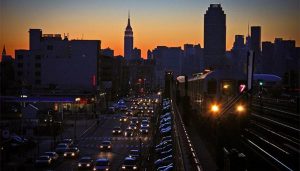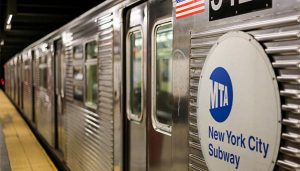 While Manhattan teems with construction sites dotted with cranes building new skyscrapers, the Big Apple will soon be even more busy underground.The city is gearing up for the most costly infrastructure renovation project in its history. The project, called “Rebuilding New York’s Transportation System”, aims first and foremost to promote sustainable mobility in New York with a record-breaking investment: $51.5 billion between 2020 and 2024, $40 billion of which will be destined for New York’s subway and bus networks.
While Manhattan teems with construction sites dotted with cranes building new skyscrapers, the Big Apple will soon be even more busy underground.The city is gearing up for the most costly infrastructure renovation project in its history. The project, called “Rebuilding New York’s Transportation System”, aims first and foremost to promote sustainable mobility in New York with a record-breaking investment: $51.5 billion between 2020 and 2024, $40 billion of which will be destined for New York’s subway and bus networks.
This ambitious project was announced by the Metropolitan Transportation Authority (MTA), the state agency in charge of managing and developing the transport networks in the city and surrounding area. New York State Governor Andrew Cuomo and the mayor of New York City, Bill de Blasio, both sit on the board.
The “2020-2024 Capital Program” increases previous five-year plan spending levels by 70%, which were already the highest ever. And it demonstrates that the city and state institutions are committed to supporting the Big Apple’s current, enormous development trajectory, and to respond to SDG 11, one of the United Nations’ Sustainable Development Goals which envisages the construction of inclusive, safe and sustainable cities. “Rebuilding New York’s Transportation System” falls within this programme.
The nation’s most-used transport network
Developing and modernising NYC’s transportation network is crucial to support one of the pillars of city’s economic vitality and lifestyle. According to data from the Metropolitan Transportation Authority, the Big Apple’s transportation network has 2 billion users each year, making it the largest of all North American cities. This is possible because the network is so extensive: 97% of New Yorkers in fact live just over 300 metres (984 feet) from a bus stop and 71% just over 700 metres (2296 feet) from a subway stop.
This extensive network, however, needs extensive work, both to modernise the older lines and to create new ones where needed. An upgraded transport network would have a direct impact not only on the quality of transport, but also on the job market and the city’s economy. The MTA points out that for every $1 billion invested in the New York transportation network, 7,300 jobs are created in the state. This means that, out of the $51 billion that will be spent in the next five years, the impact in terms of employment will be 350,000 jobs across the state.
The Metropolitan Transportation Authority therefore estimates that the five-year investment program will generate $75 billion of statewide economic activity.

Sustainable Mobility in New York: modernising the gargantuan subway network
For New York City, sustainable mobility, and in particular its subway network, is one of the key assets to reduce pollution, cut transport times, and remove traffic congestion and its costs. According to the MTA, traffic costs the region over $20 billion annually. Surface traffic forces the city’s public buses to run at an average speed of 7.4 mph (11.9 km / h). The dilapidated conditions of many of the subway lines also impacts the community. The annual cost of lost work time from commuter delays is $307 million.
That’s why more money will be spent than ever before to modernise the city’s network. A substantial part of the investments being made are designed to bring the subway system to where it is needed. The intervention program provides for the review of 418 miles of track (672 kilometers), new signals, new and more accessible stations, the purchase and implementation of new train cars and buses, as well as the creation of a new IT management system for the movement of trains.
Modern infrastructure for a changing city
New York City is at the center of a profound change. This change is visible to the naked eye in the amount of infrastructure works launched in recent months, and which will have a considerable effect on the characteristics of this city in the coming years.
The MTA estimates that by 2040, the number of inhabitants using public transport services will rise to 16.7 million people, and that there were 557,000 more daily work trips between one borough and another since 1980. This figure confirms the trend over the past 25 years, when subway and bus users outside traditional hours increased by 39%.
For New York City, like many other megacities in the world, sustainable mobility has a strategic value. Its further development is a key element for the New York City of the future.

